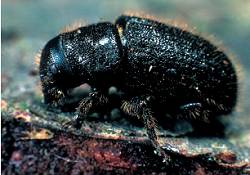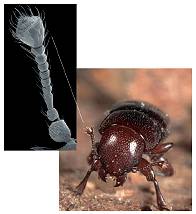An environmentally sound method of pest management to control an alien pest, the great spruce bark beetle, Dendroctonus micans.

Adult Dendroctonus micans
In forestry, exotic bark beetles are a particular threat because they can be concealed in imported timber. The most damaging species tunnel to form galleries within the bark of living trees where their larvae feed and develop, ultimately killing the tree.
In western Britain, the spruce bark beetle, Dendroctonus micans, is a well-established pest that was accidentally introduced from continental Europe. Spruce is our most important commercial tree species and managing this pest is a high priority.
Our approach to management is twofold:
The biological programme has been highly successful because of the extraordinary ability of the predator to locate its prey even when there may be only a few infested trees in the forest.
The specificity of the association between predator and bark beetle and the development of an artificial lure (see below) offers the possibility of using the predator to detect the bark beetle at the edge of its expanding range.
This could provide a much more cost-effective method of monitoring and detection than the current labour-intensive visual survey methods.

The predator Rhizophagus grandis. Sense organs that detect chemical signals from the prey are located on the antennae, one of which has been magnified (inset)
Our research focused on identifying the chemical cues that the predator uses to locate its prey.
The larvae of the bark beetle Dendroctonus micans aggregate together in a large gallery in spruce trees, eating the resinous bark and producing large amounts of faeces or ‘frass’. In behavioural experiments with the predator Rhizophagus grandis, using wind tunnels we were able to show that this frass is highly attractive to the predator, much more so than the resin that flows from the gallery entrance formed by adult bark beetles or indeed the bark itself.
We made different solvent extracts of frass and tested them individually and in combination for their ability to attract flying predators. The most attractive solvent fraction contained several resinous compounds called monoterpenes which are detected by sense organs located on the antennae.
By mixing together synthetic monoterpenes in appropriate ratios, we have obtained an artificial lure that has proved to be highly attractive not only in laboratory experiments but also when deployed as a bait in traps within the forest.
This management technique featured at the Royal Society Summer Science Exhibition – 2004, Forest Research’s exhibit, entitled ‘Biological Cruise Missile: Beetle vs. Beetle in Forest Protection’. Further details are provided in:
Royal Society Summer Science Exhibition 2004 – flier (PDF-936K)
Alternatively contact: